Carbon Emissions Associated with Organic Solid Waste Management in Developing Countries: A Brazilian Case Study
Abstract
1. Introduction
2. Materials and Methods
2.1. Study Area and Reference Data
2.2. Life Cycle Assessment (LCA)
3. Results and Discussion
4. Conclusions
Author Contributions
Funding
Data Availability Statement
Acknowledgments
Conflicts of Interest
Abbreviations
| BAU | Business As Usual |
| DOW | Domestic Organic Waste |
| DSW | Domestic Solid Waste |
| GHG | Greenhouse Gas |
| GW | Green Waste |
| IPCC | Intergovernmental Panel on Climate Change |
| LCA | Life Cycle Assessment |
| LCI | Life Cycle Inventory |
| LCIA | Life Cycle Impact Assessment |
| MSW | Municipal Solid Waste |
| OSW | Organic Solid Waste |
| PAH | Polycyclic Aromatic Hydrocarbons |
| SDG | Sustainable Development Goal |
References
- Paes, M.X.; de Oliveira, J.A.P.; Mancini, S.D.; Rieradevall, J. Waste management intervention to boost circular economy and mitigate climate change in cities of developing countries: The case of Brazil. Habitat Int. 2024, 143, 102990. [Google Scholar] [CrossRef]
- Lino, F.A.; Ismail, K.A.; Castañeda-Ayarza, J.A. Municipal solid waste treatment in Brazil: A comprehensive review. Energy Nexus 2023, 11, 100232. [Google Scholar] [CrossRef]
- ABREMA—Brazilian Association of Waste and Environment. Panorama of the Solid Residues in Brazil. 2024. Available online: https://static.poder360.com.br/2024/12/panorama-dos-residuos-solidos-no-brasil-2024.pdf (accessed on 18 August 2025).
- Saghi, M.H.; Nadimi, H.; Eslami, A.; Alavi Bakhtiarvand, S.N.; Oghazyan, A.; Setoudeh, S.; Sargolzaei, M.S. Characteristics and pollution indices of leachates from municipal solid waste landfills in Iranian metropolises and their implications for MSW management. Sci. Rep. 2024, 14, 27285. [Google Scholar] [CrossRef] [PubMed]
- Rouhani, A.; Hejcman, M. A review of soil pollution around municipal solid waste landfills in Iran and comparable instances from other parts of the world. Int. J. Environ. Sci. Technol. 2025, 22, 9711–9728. [Google Scholar] [CrossRef]
- Abubakar, I.R.; Maniruzzaman, K.M.; Dano, U.L.; AlShihri, F.S.; AlShammari, M.S.; Ahmed, S.M.; Al-Gehlani, W.A.; Alrawaf, T.I. Environmental sustainability impacts of solid waste management practices in the global South. Int. J. Environ. Res. Public Health 2022, 19, 12717. [Google Scholar] [CrossRef] [PubMed]
- Brazil. Brazil Presents Its New Climate Target Aligned with Mission 1.5 °C. November 2024. Available online: https://www.gov.br/planalto/en/latest-news/2024/11/brazil-presents-its-new-climate-target-aligned-with-mission-1.5oc (accessed on 18 August 2025).
- Brazil—Ministry of Science, Technology and Innovations. 4th National Inventory of Anthropogenic Emissions and Removals of Greenhouse Gases: Reference Reports—Historical Series 1990–2022. Brasília: MCTI; 2023. Available online: https://www.gov.br/mcti/pt-br/acompanhe-o-mcti/sirene/publicacoes/relatorios-bienais-de-transparencia-btrs/Relatorio_deInventario_NacionalNIR_2024_PORT.pdf (accessed on 18 August 2025).
- Castro, M.A.S.; Lafratta, J.M.; Moura, P.S.D. Context and prospects for decentralized composting of Municipal Solid Waste in Brazil. Natl. J. City Manag. 2023, 11, 243–257. [Google Scholar] [CrossRef]
- Brazil. Law No. 12.305/2010. National Solid Waste Policy. Establishes the National Solid Waste Policy; Amends Law No. 9,605 of February 12, 1998; and Makes Other Provisions. Official Gazette of the Union. 2010. Available online: https://www.planalto.gov.br/ccivil_03/_ato2007-2010/2010/lei/l12305.htm (accessed on 18 August 2025).
- Ibáñez-Fores, V.; Bovea, M.D.E.; Nóbrega, C.C.; García, H.R.M.; Lins, R.B. Temporal Evolution of the Environmental Performance of Implementing Selective Collection in Municipal Waste Management Systems in Developing Countries: A Brazilian Case Study. Waste Manag. 2018, 72, 65–77. [Google Scholar] [CrossRef] [PubMed]
- Colvero, D.A.; Pfeiffer, S.C.; Ramalho, J.C.M.; do Nascimento, A.A.; de Lima, A.C.A. Identification of environmental impacts associated with municipal solid waste management through life cycle assessment. Int. J. Environ. Sci. Technol. 2025, 22, 5929–5946. [Google Scholar] [CrossRef]
- Silva, V.; Contreras, F.; Bortoleto, A.P. Life-cycle assessment of municipal solid waste management options: A case study of refuse derived fuel production in the city of Brasilia, Brazil. J. Clean. Prod. 2021, 279, 123696. [Google Scholar] [CrossRef]
- Leite, F.F.; Palacio, J.C.E.; Batista, M.J.A.; Renó, M.L.G. Evaluation of technological alternatives for the treatment of urban solid waste: A case study of Minas Gerais, Brazil. J. Clean. Prod. 2022, 330, 129618. [Google Scholar] [CrossRef]
- Ramalho, J.C.M.; Calmon, J.L.; Colvero, D.A.; Vieira, D.; Bravo, A. Life cycle assessment of municipal solid waste management strategies for midsized metropolitan areas in developing countries. J. Mater. Cycles Waste Manag. 2025, 27, 638–653. [Google Scholar] [CrossRef]
- Oliveira, B.O.S.; de Medeiros, G.A.; Mancini, S.D.; Paes, M.X.; Gianelli, B.F. Eco-efficiency transition applied to municipal solid waste management in the Amazon. J. Clean. Prod. 2022, 373, 133807. [Google Scholar] [CrossRef]
- Araujo, Y.R.V.; Souza, B.I.; Carvalho, M. Greenhouse gas emissions associated with tree pruning residues of urban areas of Northeast Brazil. Resources 2024, 13, 127. [Google Scholar] [CrossRef]
- IBGE. Instituto Brasileiro de Geografia e Estatística. 2022. Available online: https://www.ibge.gov.br/cidades-e-estados/pb/joao-pessoa.html (accessed on 18 August 2025).
- João Pessoa. João Pessoa Municipal Plan for Integrated Management of Solid Residues: Volumes I and II. 2014. Available online: https://leismunicipais.com.br/a/pb/j/joao-pessoa/lei-ordinaria/2014/1295/12957/lei-ordinaria-n-12957-2014-dispoe-sobre-o-plano-municipal-de-gestao-integrada-de-residuos-solidos-no-municipio-de-joao-pessoa-e-aprova-o-plano-municipal-de-gestao-integrada-de-residuos-solidos-apreciado-pelo-comam (accessed on 17 November 2025).
- Nobrega, C.C.; Carvalho, M.; Garcia, H.R.D.M.; Forés, V.I.; Bovea, M.D. Life cycle assessment of selective paper and cardboard collection of in the Bessa Nucleus, municipality of Joao Pessoa/Paraiba, Brazil. Eng. Sanitária E Ambient. 2019, 24, 875–886. [Google Scholar] [CrossRef]
- ISO 14040; Environmental Management—Life Cycle Assessment—Principles and Framework. International Organization for Standardization—ISO: Geneva, Switzerland, 2006.
- ISO 14044; Environmental Management—Life Cycle Assessment—Requirements and Guidelines. International Organization for Standardization—ISO: Geneva, Switzerland, 2006.
- Guinée, J.B.; Lindeijer, E. Handbook on Life Cycle Assessment: Operational Guide to the ISO Standards; Springer Science & Business Media: Berlin/Heidelberg, Germany, 2002; Volume 7. [Google Scholar]
- Carvalho, M.; Delgado, D. Potential of photovoltaic solar energy to reduce the carbon footprint of the Brazilian electricity matrix. LALCA-Rev. Lat.-Am. Avaliação Ciclo Vida 2017, 1, 64–85. [Google Scholar] [CrossRef]
- Energy Research Company. Yearly Reports of Electricity 2024. 2024. Available online: https://www.epe.gov.br/pt/publicacoes-dados-abertos/publicacoes/anuario-estatistico-de-energia-eletrica (accessed on 17 November 2025).
- Energy Research Company. Decennial Plan for Electricity Expansion 2024. Available online: https://www.epe.gov.br/pt/publicacoes-dados-abertos/publicacoes/plano-decenal-de-expansao-de-energia-2034 (accessed on 17 November 2025).
- Gomes, L.P.; Kohl, C.A.; Souza, C.L.D.L.; Rempel, N.; Miranda, L.A.S.; Moraes, C.A.M. Avaliação ambiental de aterros sanitários de resíduos sólidos urbanos precedidos ou não por unidades de compostagem. Eng. Sanit. Ambient. 2015, 20, 449–462. [Google Scholar] [CrossRef]
- McDougall, F.R.; White, P.; Franke, M.; Hindle, P. Integrated Solid Waste Management: A Life Cycle Inventory; Blackwell Science: Oxford, UK, 2001. [Google Scholar]
- SIMAPRO. Life Cycle Assessment Software. 2024. Available online: https://network.simapro.com/pre/ (accessed on 4 November 2025).
- Ecoinvent Database. 2023. Available online: http://www.ecoinvent.ch (accessed on 4 November 2025).
- Intergovernmental Panel on Climate Change—IPCC. Revised Supplementary Methods and Good Practice Guidance Arising from the Kyoto Protocol. 2013. Available online: http://www.ipcc-nggip.iges.or.jp/public/kpsg/ (accessed on 4 November 2025).
- Yeo, D.; Dongo, K.; Mertenat, A.; Lüssenhop, P.; Körner, I.; Zurbrügg, C. Material flows and greenhouse gas emissions reduction potential of decentralized composting in sub-Saharan Africa: A case study in Tiassalé, Côte D’Ivoire. Int. J. Environ. Res. Public Health 2020, 17, 7229. [Google Scholar] [CrossRef]
- Ouedraogo, A.S.; Kumar, A.; Frazier, R.; Sallam, K.A. Comparative life cycle assessment of landfilling with sustainable waste management methods for municipal solid wastes. Environments 2024, 11, 248. [Google Scholar] [CrossRef]
- Cocarta, D.M.; Rada, E.C.; Ragazzi, M.; Badea, A.; Apostol, T.J.E.T. A contribution for a correct vision of health impact from municipal solid waste treatments. Environ. Technol. 2009, 30, 963–968. [Google Scholar] [CrossRef] [PubMed]
- Andreottola, G.; Ragazzi, M.; Foladori, P.; Villa, R.; Langone, M.; Rada, E.C. The unit intregrated approach for OFMSW treatment. UPB Sci. Bull. Ser. C Electr. Eng. 2012, 74, 19–26. [Google Scholar]
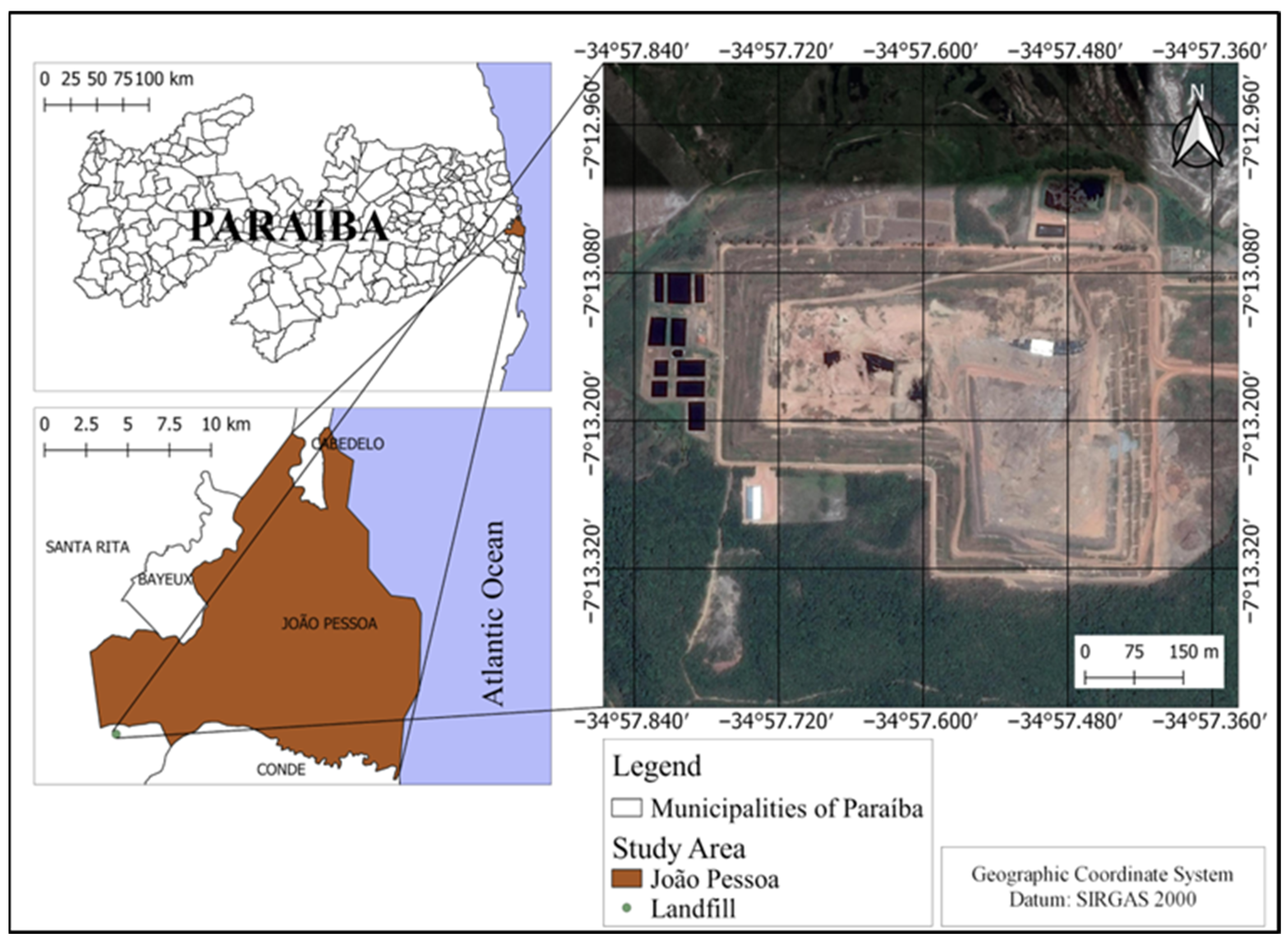


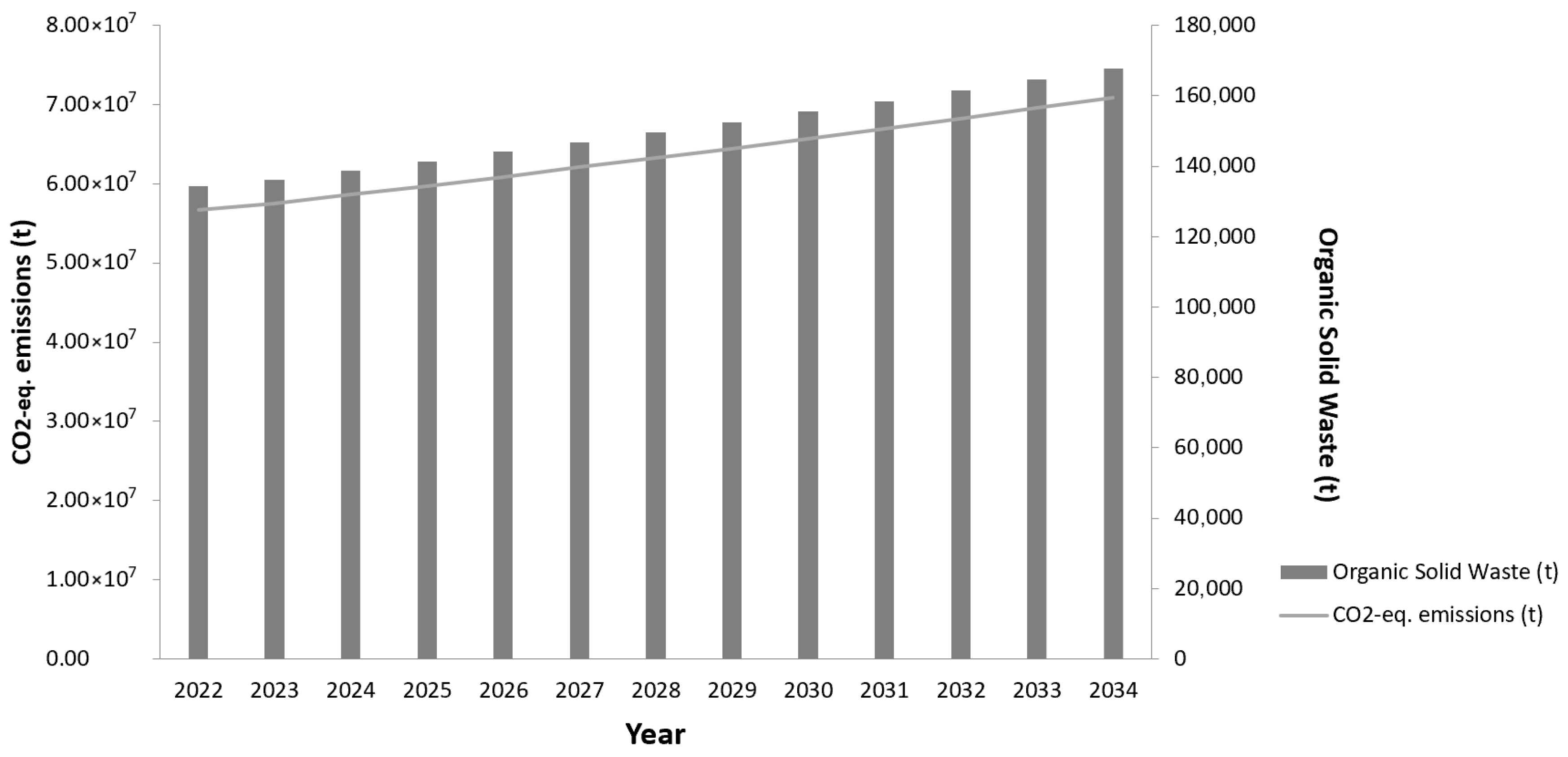
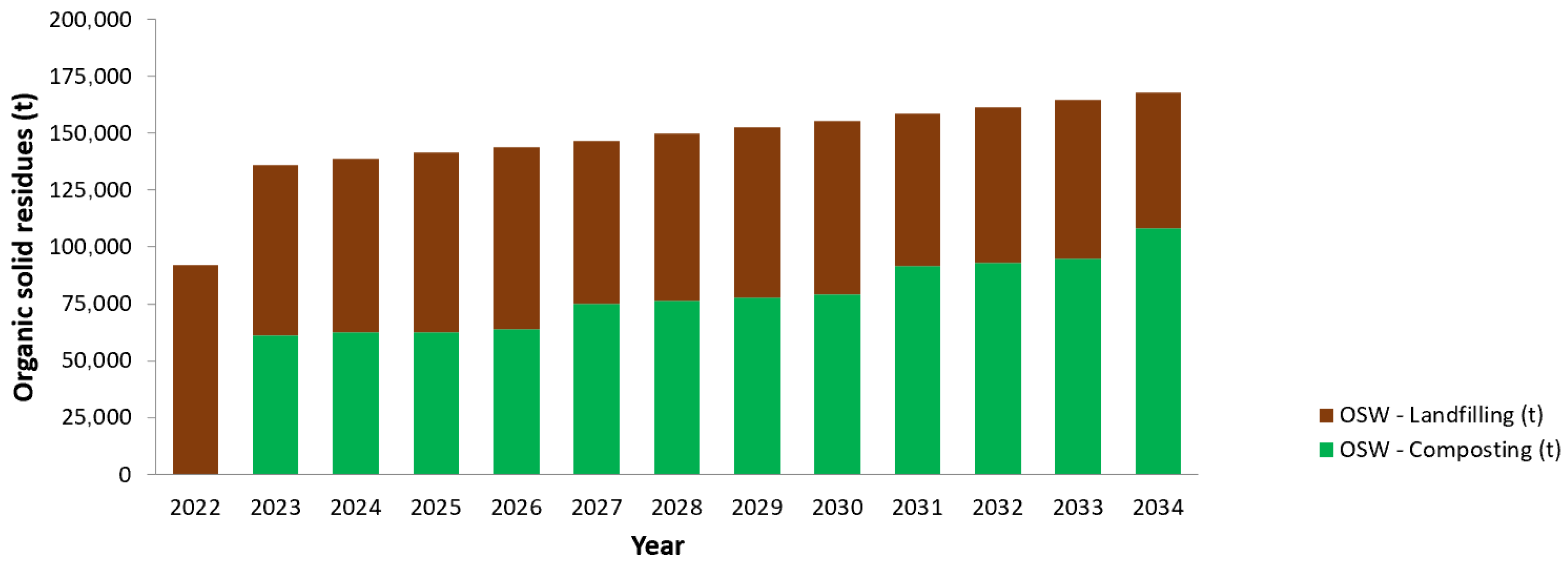
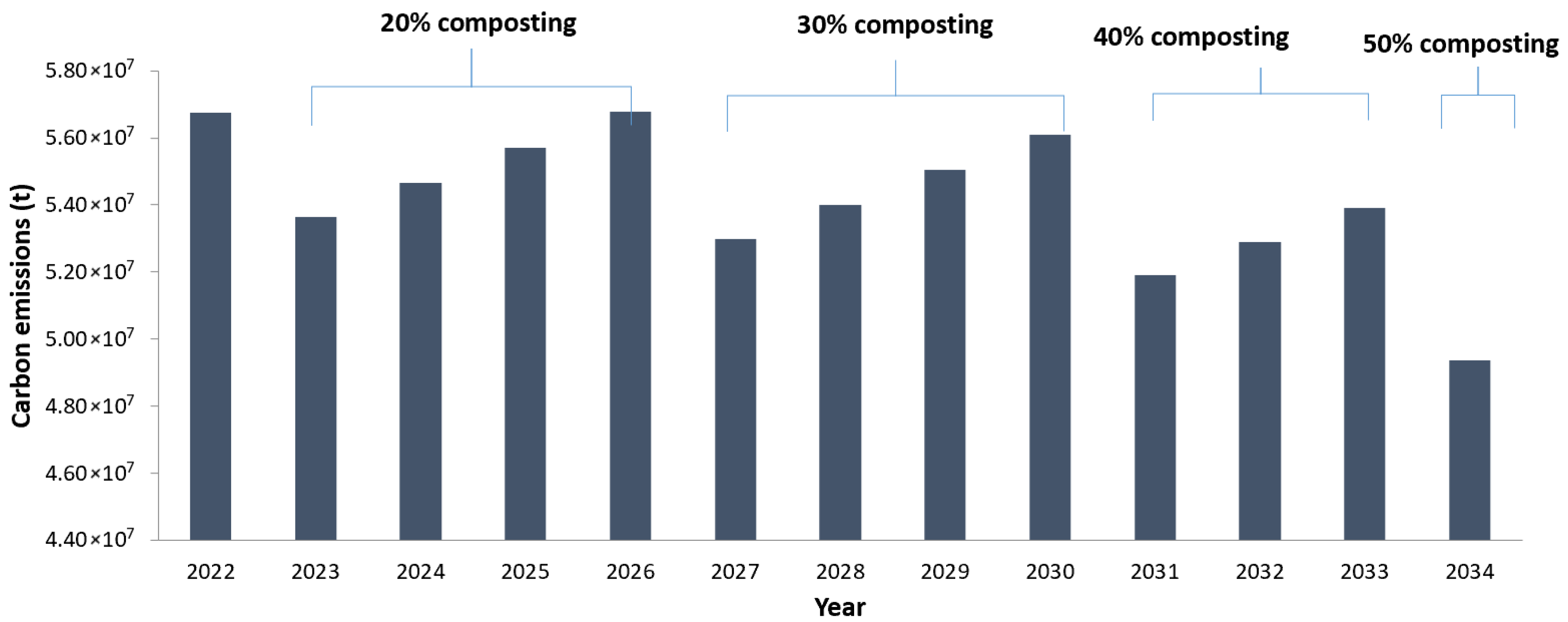
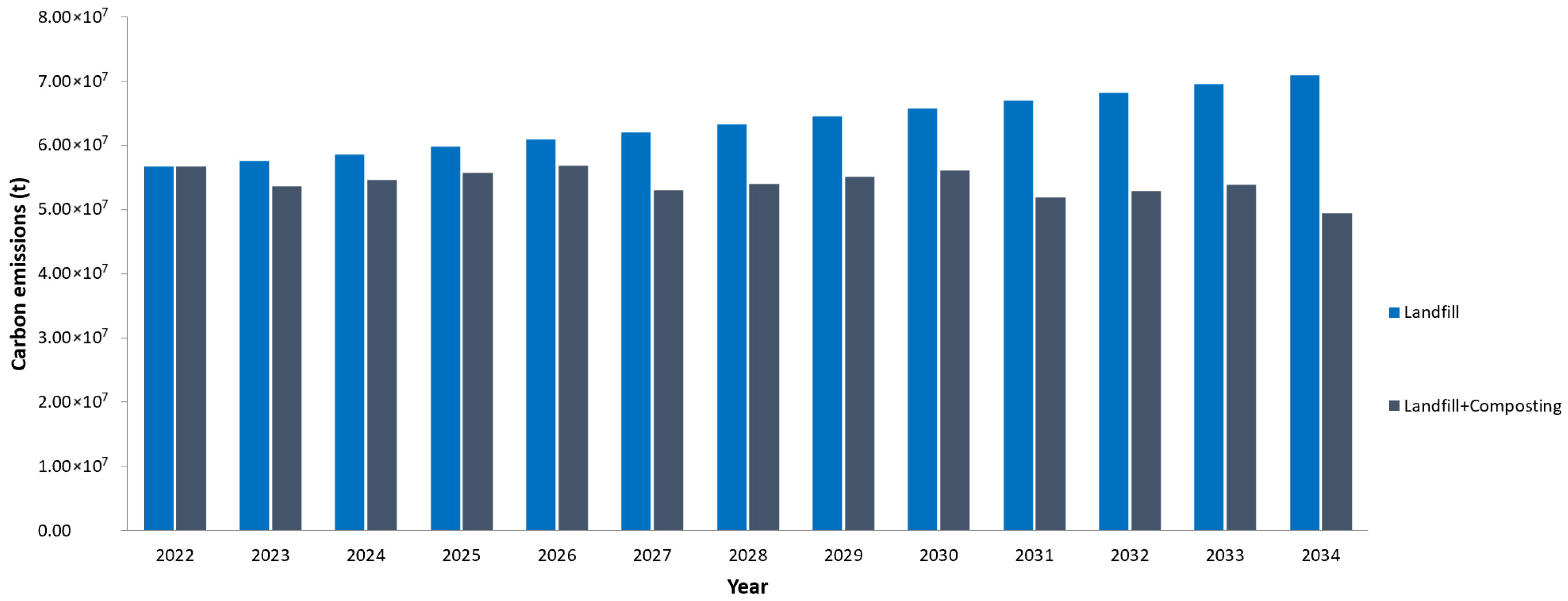
| Year | Population | DSW (t) | DOW (t) | GW (t) | Total OSW (t) |
|---|---|---|---|---|---|
| 2022 | 833,932 | 263,203.00 | 92,121.05 | 42,112.48 | 134,233.53 |
| 2023 | 849,943 | 266,797.26 | 93,379.04 | 42,687.56 | 136,066.60 |
| 2024 | 866,262 | 271,919.77 | 95,171.92 | 43,507.16 | 138,679.08 |
| 2025 | 882,895 | 277,140.63 | 96,999.22 | 44,342.50 | 141,341.72 |
| 2026 | 899,846 | 282,461.73 | 98,861.61 | 45,193.88 | 144,055.48 |
| 2027 | 917,123 | 287,885.00 | 100,759.75 | 46,061.60 | 146,821.35 |
| 2028 | 934,732 | 293,412.39 | 102,694.34 | 46,945.98 | 149,640.32 |
| 2029 | 952,679 | 299,045.90 | 104,666.07 | 47,847.34 | 152,513.41 |
| 2030 | 970,970 | 304,787.59 | 106,675.66 | 48,766.01 | 155,441.67 |
| 2031 | 989,613 | 310,639.51 | 108,723.83 | 49,702.32 | 158,426.15 |
| 2032 | 1,008,614 | 316,603.79 | 110,811.33 | 50,656.61 | 161,467.93 |
| 2033 | 1,027,979 | 322,682.58 | 112,938.90 | 51,629.21 | 164,568.12 |
| 2034 | 1,047,716 | 328,878.08 | 115,107.33 | 52,620.49 | 167,727.82 |
| Year | Scenario 1 | Scenario 2 | |||
|---|---|---|---|---|---|
| OSW for Landfill (t) | Goal | (%) | OSW for Landfill (t) | OSW for Composting ** (t) | |
| 2022 | 134,233.53 | - | - | 134,233.53 | 0 |
| 2023 | 136,066.60 | 1 | 20 * | 74,703.23 | 61,363.37 |
| 2024 | 138,679.08 | 76,137.54 | 62,541.55 | ||
| 2025 | 141,341.72 | 77,599.38 | 63,742.34 | ||
| 2026 | 144,055.48 | 79,089.28 | 64,966.20 | ||
| 2027 | 146,821.35 | 2 | 30 * | 70,531.82 | 76,289.52 |
| 2028 | 149,640.32 | 71,886.03 | 77,754.28 | ||
| 2029 | 152,513.41 | 73,266.25 | 79,247.16 | ||
| 2030 | 155,441.67 | 74,672.96 | 80,768.71 | ||
| 2031 | 158,426.15 | 3 | 40 * | 65,234.30 | 93,191.85 |
| 2032 | 161,467.93 | 66,486.80 | 94,981.14 | ||
| 2033 | 164,568.12 | 67,763.34 | 96,804.77 | ||
| 2034 | 167,727.82 | 4 | 50 * | 57,553.66 | 110,174.16 |
Disclaimer/Publisher’s Note: The statements, opinions and data contained in all publications are solely those of the individual author(s) and contributor(s) and not of MDPI and/or the editor(s). MDPI and/or the editor(s) disclaim responsibility for any injury to people or property resulting from any ideas, methods, instructions or products referred to in the content. |
© 2025 by the authors. Licensee MDPI, Basel, Switzerland. This article is an open access article distributed under the terms and conditions of the Creative Commons Attribution (CC BY) license (https://creativecommons.org/licenses/by/4.0/).
Share and Cite
Carvalho, M.; Costa, S.G.F.d.; Lins, R.B.; Macieira, M.L.d.L.; Virgolino, J.L.F.; Nóbrega, C.C.; Abrahao, R. Carbon Emissions Associated with Organic Solid Waste Management in Developing Countries: A Brazilian Case Study. Resources 2025, 14, 178. https://doi.org/10.3390/resources14120178
Carvalho M, Costa SGFd, Lins RB, Macieira MLdL, Virgolino JLF, Nóbrega CC, Abrahao R. Carbon Emissions Associated with Organic Solid Waste Management in Developing Countries: A Brazilian Case Study. Resources. 2025; 14(12):178. https://doi.org/10.3390/resources14120178
Chicago/Turabian StyleCarvalho, Monica, Samara Gonçalves Fernandes da Costa, Raíssa Barreto Lins, Milca Laís da Luz Macieira, Julia Lessa Feitosa Virgolino, Claudia Coutinho Nóbrega, and Raphael Abrahao. 2025. "Carbon Emissions Associated with Organic Solid Waste Management in Developing Countries: A Brazilian Case Study" Resources 14, no. 12: 178. https://doi.org/10.3390/resources14120178
APA StyleCarvalho, M., Costa, S. G. F. d., Lins, R. B., Macieira, M. L. d. L., Virgolino, J. L. F., Nóbrega, C. C., & Abrahao, R. (2025). Carbon Emissions Associated with Organic Solid Waste Management in Developing Countries: A Brazilian Case Study. Resources, 14(12), 178. https://doi.org/10.3390/resources14120178







